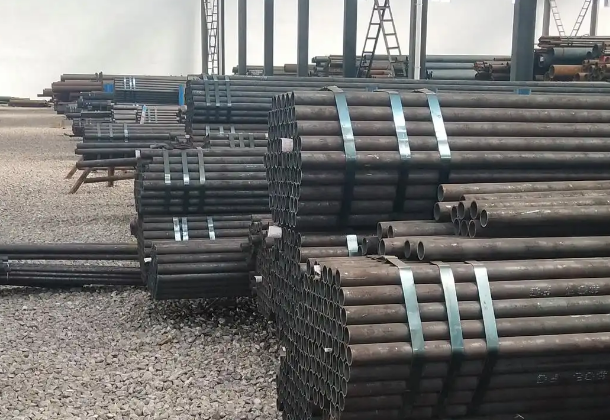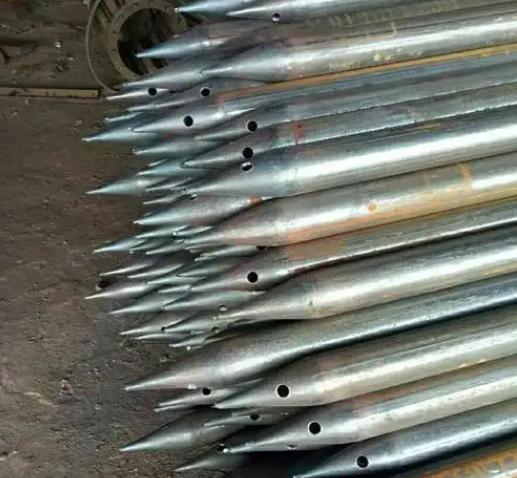Seamless steel pipe for tunnels is a special type of steel pipe used in the construction of tunnels and other underground projects. It is typically made of high-density, high-strength materials, such as
carbon steel seamless or alloy steel seamless. Tunnel seamless pipes are characterized by their lack of welds, thus reducing the risk of leaks and engineering defects. Furthermore, since they are manufactured in a single operation, consistent quality and performance can be ensured. Consequently, seamless steel pipes for tunnels are widely used in underground projects.
Seamless steel pipe used in tunnel projects typically requires high strength, corrosion resistance, pressure resistance, and earthquake resistance to withstand complex geological environments and the demands of long-term use.

Common Uses of Seamless Steel Pipe in Tunneling:
1. Support Structures: Used for initial or permanent tunnel support, such as steel arches and pipe sheds.
2. Drainage Systems: Serves as drainage pipes to remove water seepage within tunnels.
3. Ventilation Ducts: Transport fresh air or exhaust exhaust gases.
4. Grouting Ducts: Used for grouting to reinforce surrounding rock.
Seamless steel pipes, as advanced support structures, are an indispensable component of tunnel construction. Seamless steel pipes play a vital role in tunnel support, providing reliable support to prevent collapse of the tunnel roof and sidewalls, ensuring construction safety.
Seamless steel pipes offer high strength, rigidity, and durability, effectively bearing and supporting the rock and soil surrounding the tunnel. In tunnel support, seamless steel pipes are combined with steel arches, steel mesh, shotcrete, and other components to form a reliable support system, ensuring safe tunnel construction.
The application of seamless steel pipes in tunnel support has the following characteristics:
1. High Strength: Seamless steel pipes have high yield strength and tensile strength, capable of withstanding heavy loads and ensuring effective support during tunnel construction.
2. Good Rigidity: Seamless steel pipes have a high elastic modulus, providing reliable support and effectively preventing deformation and collapse of the tunnel.
3. Good Durability: Seamless steel pipes undergo anti-corrosion treatment to effectively prevent corrosion inside and outside the tunnel, ensuring long-term performance.
4. Easy Installation: Seamless steel pipes can be connected to other components via connectors to form a complete support system, making installation quick and easy.
5. Wide Application: Seamless steel pipes are suitable for various types of tunnel construction, including railways, highways, water conservancy projects, and mining projects.
In tunnel construction, the advanced support provided by seamless steel pipes effectively prevents collapse of the tunnel roof and sidewalls, ensuring construction safety. Furthermore, seamless steel pipes offer high strength, high rigidity, and high durability, providing reliable support and ensuring seamless, high-quality, and safe tunnel construction. They play a vital role in tunnel construction.
How to Select the Material for Seamless Steel Pipes for Tunnels?
Tunnel seamless steel pipes are produced using a special production process, heating the steel billet to a high temperature and then continuously rolling it on a rolling mill. Compared to ordinary steel pipes, seamless steel pipes for tunnels have no seams and are more durable. They offer pressure resistance, high strength, corrosion resistance, and wear resistance, making them suitable for a variety of harsh tunnel environments.
The material selection for seamless steel pipes for tunnels is crucial. The material used for seamless steel pipes in tunnels should possess excellent strength and rigidity to withstand the external loads and internal water pressures inherent in tunnel geology. Generally, carbon steel, alloy steel, and stainless steel are commonly used. Carbon steel is suitable for general tunneling projects, offering high strength and corrosion resistance. Alloy steel exhibits improved corrosion resistance and corrosion resistance in specialized geological environments. Stainless steel is primarily used for tunneling projects with specialized requirements, such as those requiring high corrosion, erosion, and wear resistance.

Common Materials and Standards:
Material: High-quality carbon steel (such as Q235, Q345) or low-alloy steel is commonly used. Stainless steel or weathering steel may be used in specialized environments.
Standards:
International Standards:
ASTM A106 (High-Temperature Service) and
ASTM A53 (General Purpose).
Chinese Standards: GB/T 8162 (Seamless Steel Pipe for Structural Use) and GB/T 17395 (Seamless Steel Pipe Size Series).
Corrosion Protection: Galvanizing, epoxy coating, or polyethylene coating are required to resist groundwater and chemical corrosion.
Construction Requirements for Seamless Steel Pipes for Tunnels:
Before construction of seamless steel pipes for tunnels, a detailed tunnel engineering survey and design must be conducted to determine the specifications and length of the seamless steel pipes. Secondly, the construction sequence and method of the seamless steel pipes must be rationally arranged based on the tunnel's geological conditions and water levels. For example, in soft soil tunnel construction, either the pipe jacking method or the pipe-jacking method can be used. Finally, the quality and safety of the seamless steel pipes must be ensured. During construction, the construction must be carried out strictly in accordance with the engineering design and relevant specifications to ensure the installation accuracy and quality of the seamless steel pipes. After completion, an inspection and acceptance inspection must be carried out to ensure the integrity and performance of the seamless steel pipes.
Maintenance and Care:
The maintenance and care of seamless steel pipes for tunnels also cannot be neglected. Generally speaking, maintenance of seamless steel pipes for tunnels mainly includes cleaning, corrosion protection, painting, and regular inspections. Cleaning and corrosion protection are important measures to keep the seamless steel pipe surface clean and prevent corrosion. Painting further enhances the seamless steel pipe's corrosion resistance. Regular inspections can promptly detect damage and cracks in the seamless steel pipes, allowing appropriate maintenance measures to be implemented, thereby extending the service life of the seamless steel pipes.
Design Considerations for Seamless Tunnels:
Wall Thickness: Calculated and determined based on tunnel depth, surrounding rock pressure, and hydrological conditions (usually 6-20mm).
Connection Methods:
Flange, threaded, or welded, taking into consideration ease of construction and sealing.
Seismic Design: Increased pipe flexibility or the use of special joints are required in seismically active areas.
Seamless vs. Welded Steel Pipe:
Seamless steel pipe: Has no weld weaknesses, offers higher pressure-bearing capacity, and is suitable for high-pressure, high-stress environments.
Welded steel pipe: Lower cost, suitable for low-pressure or non-load-bearing applications (such as some drainage pipes).
Read more: Steel Pipe Dimensions & Sizes or Schedule 80 Steel Pipe



